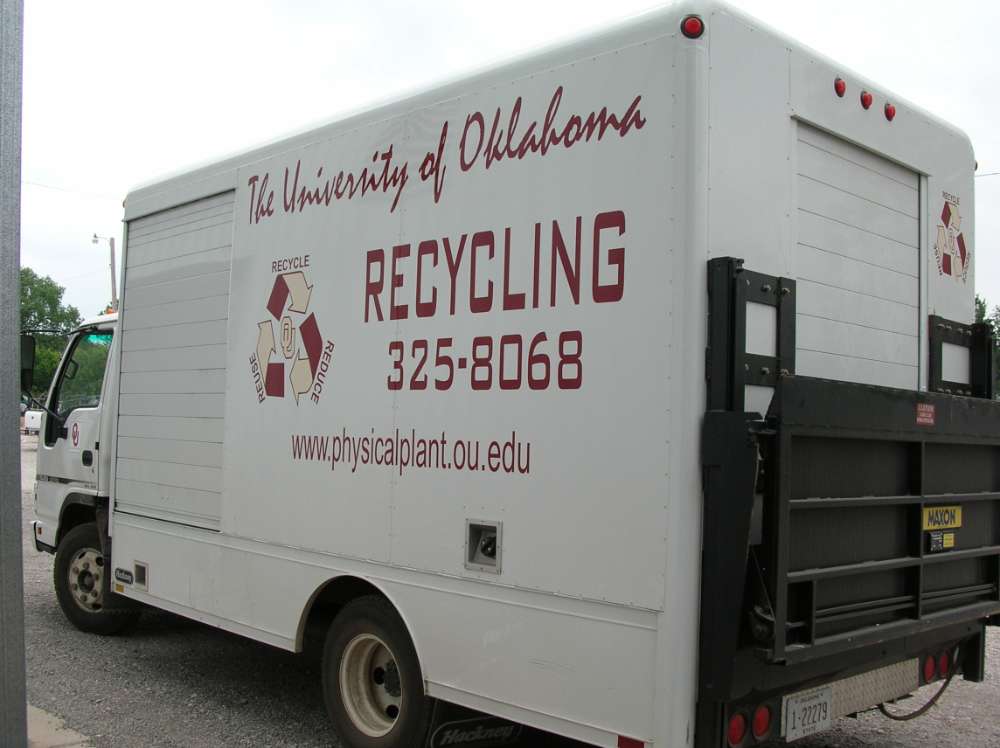Reducing Waste, Recycling for the Future

In terms of environmental benefits, diverting 480 tons of material from the landfill has the greenhouse gas benefit equivalent of 1,750 metric tons of carbon dioxide equivalents. In terms of more comprehensible values, this would be the similar to:
When a material is recycled, it is used in place of virgin inputs in the manufacturing process, rather than being disposed of and managed as waste. As a result, recycling reduces emissions in two ways: (1) recycling offsets upstream emissions associated with raw material acquisition, the manufacture and transport of virgin inputs, and (2) it allows for the carbon stored in forests to remain sequestered (when wood and paper is recycled).
*Not accepted: glass, styrofoam or plastic film*
Signage for Recycling and Refuse Materials:
Before placing an item in your recycling bin, make sure that it is dry, empty and clear of food residue, etc. Only recycle items listed as an accepted material. "Wishful recycling" contaminates the recycling stream, can damage equipment and increases sorting costs.
Toner cartridges, batteries, pallets and metals are also accepted but these items require special coordination.
It is the intent to respond to calls and emails regarding recycling inquiries within 5 business days.
Please note, files can be shredded and recycled upon request. Locked toters are available to ensure materials are secure at all times.
The Recycling and Refuse team strives to make the choice to recycle as easy as possible by providing bins all across campus, including in residence halls, offices, classrooms, hallways and along sidewalks. Look for blue bins inside campus buildings, Bigbelly units and outdoor receptacles with blue lids along the sidewalks, and trailers across campus for cardboard/paperboard collection. Everyone is responsible for taking materials from their desk-side recycling container to the larger, common area recycling receptacles. Check the labeling on each receptacle to see which material(s) the bin accepts. Remember to empty remaining liquids and food debris from items before recycling to keep contaminants out of the recycling stream. Email recycling@ou.edu to order additional recycling containers for your department.
Employees are provided recycling containers for their paper, plastic and aluminum. When personal office recycling containers are full, empty the materials into the larger recycling containers within the department. Check the labeling on each receptacle to see what materials the bin accepts. Larger recycling containers are divided into two categories (1) one for paper (white paper, mixed paper, newspaper) and (2) the other for both plastics and metals (plastic #1-7 and aluminum). If your larger recycling containers are not labeled as either “paper” or “aluminum,” decide as an office which bins you will designate as paper and which you will designate as aluminum, then be consistent with how you sort the materials.
These areas will have larger blue bins designated to accept either (1) paper (white paper, mixed paper, newspaper) or (2) plastics and metals (plastic #1-7 and aluminum). Check the labeling on each receptacle to see what materials the bin accepts.
Bigbelly units as well as outdoor pedestrian receptacles with blue dual purpose lids line campus sidewalks. The containers accept plastic (#1-7) and aluminum.
Cardboard trailers accept broken down cardboard and paperboard (cereal boxes, milk boxes, toilet and paper towel rolls, etc). The locations for cardboard trailers are as follows:
For those who are living off campus and may not have the ability to recycle at their apartment or home, a recycling trailer can be accessed 24/7 at the south campus recycling center located at 525 Columbus Street. The rolloff is partitioned to accept plastics #1-7, cardboard, and aluminum/metals.
Recycling first came to the University of Oklahoma campus in 1991. In 1998, President David L. Boren directed a significant expansion of the program to include the collection of aluminum, plastic, newspaper and cardboard across campus. OU Recycling and Refuse was recognized by Oklahoma City Earth Day in 2000 and was given the Environmental Excellence Award.
Located inside of campus buildings are containers lined with blue bags which are used to collect recyclable materials. Buildings keep their recyclable materials separated by designating specific containers for specific materials. For example, a building will designate one container for paper and another container for both plastic and aluminum. When the bins are full, the custodial and housekeeping staff remove recycling from inside of the buildings and deposit the blue bags into the large plastic recycling toters which are located outside of the building.
The recycling and refuse team takes over from here. The team collects recycling which has been deposited into the toters as well as what has collected in the pedestrian recycling bins (the bins located along the sidewalks across campus) and the cardboard trailers.
Once the recyclables are collected from the toters, pedestrian bins, and trailers, the recycling and refuse team transports the materials in an enclosed vehicle to the recycling facility on South Campus where the materials are hand sorted. Paper is shredded, then the paper, aluminum, and plastics are baled.
